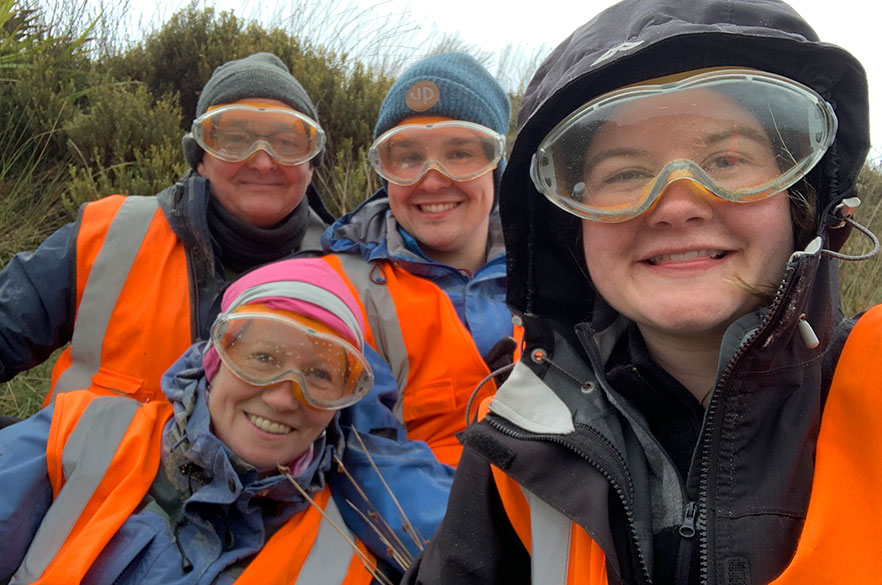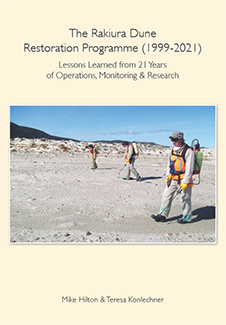
A new book from the School of Geography goes beyond celebrating the Department of Conservation's 20-plus-year efforts to restore dunes on Rakiura Stewart Island - it also shows the value of collaborative relationships for students, staff, and our unique coastal environment.
School of Geography Associate Professor Mike Hilton (above, back left) says The Rakiura Dune Restoration Programme (1999-2021); Lessons learned from 21 years of operations, monitoring and research is an indicator of the strong relationship the University and the School has developed with the Department of Conservation over more than two decades.

"The support and funding provided by DOC for the dune project contract has ensured students have each been guaranteed three to six 10-day field trips during their master's or PhD, and 33 postgraduate theses of dissertations have been completed on some aspect of the geomorphology and ecology of Rakiura or the process of dune restoration, plus related staff and student publications. The book is based almost entirely on these outputs."
Between 200 and 300 volunteers have participated in fieldwork over the last 20 years, all University of Otago students, as volunteers, or as members of undergraduate classes
"Rakiura has been a wonderful laboratory for staff and students, and I'm sure the experience has contributed positively to their university experience."
Associate Professor Hilton says the book also highlights how conservation initiatives benefit from sustained relationships between universities, external agencies, iwi and local authorities.
What is the book about?
Briefly .. dune restoration, specifically restoring the habitat of a distinctive dune flora and fauna. The native biodiversity of dune systems is related to sand movement and exotic plants, particularly marram grass, create a dense cover of vegetation that prevents sand and sand dunes moving, resulting in complex topographies and native plant communities being converted to stable grasslands.
Why did you undertake this project?
Chance really. I responded to a request by the Department of Conservation (DOC) in 1997 for advice, visited a dune system in southern Rakiura (Doughboy Bay) and we've been working with DOC since.
But this book was meant to celebrate 21 years of the world's largest dynamic dune restoration project, specifically the work of a great many DOC rangers and managers, as well as staff and students from the University of Otago. It is largely based on 32 postgraduate theses and dissertations, papers, undergraduate projects and conference presentations. Co-author Dr Teresa Konlechner and I thought it was time to bring all this work together while applauding the Department and the ongoing collaboration between DOC and the University.
Are the findings on marram grass, and the methods of restoration for our vital coastal dune environments scalable? Where else could we apply these findings, and where do you see as a critical area for conservation efforts?
The processes of invasive species operations and control, monitoring, measuring success, species and community recovery and landscape change, could be applied to a wide range of weeds and environments; and should be of value to local government, iwi and hapu, and local communities in a range of situations.
The knowledge gained in relation to marram is important because most of the beaches and dunes of central and southern New Zealand are marram dominated, with low native plant values. Only intensively managed dunes, where marram is targeted on an annual basis, have retained conservation values, with corresponding loss of flora and fauna.
Marram is also the main threat to dune systems on temperate coasts throughout the northern and southern hemisphere, including Australia, South Africa and South Americal in our hemisphere, so we hope the knowledge gained on Rakiura can have an international impact.
What are some species impacted by marram's spread?
All native plant species that only occur in dune systems, particularly the large active dune systems of southern New Zealand. But also key bird species, such as the New Zealand dotterel/tūturiwhatu, southern sub-species, which flock in large open, semi-vegetated dunes. We know less about the invertebrates and many of the non-vascular plants, but many are probably only found in dune systems. They are not well studied, despite their distinctive character.
You should read this book if . . .
You want to be inspired to restore or participate in the restoration of local dune systems; or are interested in the natural (dynamic) character of dune systems. The lessons learned will guide stakeholders in how they approach similar projects and how to address key challenges in the restoration process.
I hope this book makes people think about . . . .
The commitment and hard work of the Department of Conservation staff, who undertake laborious tasks year after year to control invasive species; the benefits of forming collaborations between all stakeholder groups, but particularly between academics and (all) other stakeholders; to maintain involvement in projects over years or even decades - it's a great way to learn and a wonderful opportunity for students; how much of our dune-related biodiversity has been lost; opportunities to do something about it.